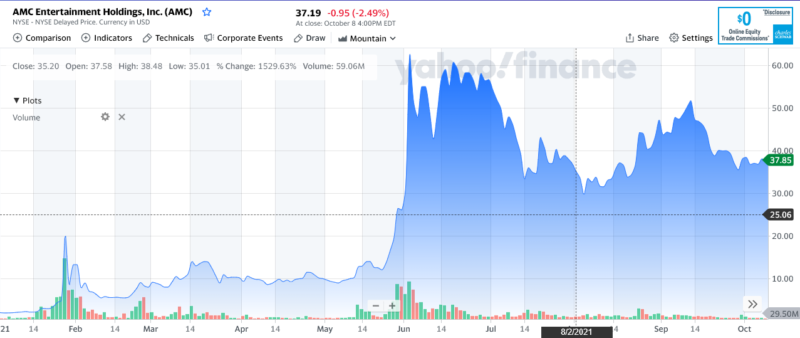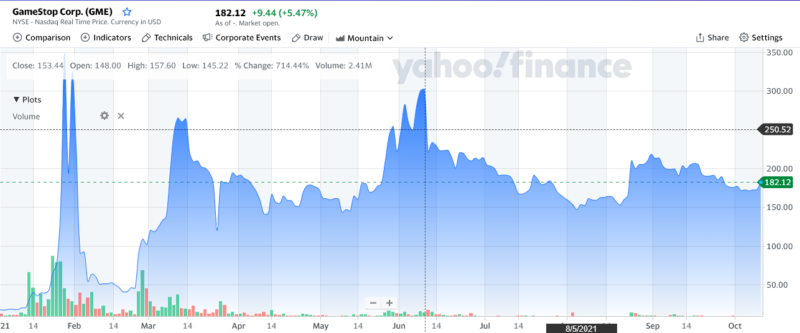If you pay attention to investment news, you’ve likely heard of the term, meme stock. Much like crypto, meme stocks dominated the headlines in 2021. And like crypto, they are highly speculative investments, which begs the question: is it a good idea to invest in meme stocks, or should you avoid them at all costs?
Table of Contents
What Is a Meme Stock?
A stock is labeled as a “meme stock” when the price skyrockets based on nothing more than social media hype. More specifically, individual investors use social media platforms to create a buzz around the stock, which results in a buying frenzy. Pretty soon, the stock’s price no longer resembles its true value.
Exactly where the word “meme” enters the picture is a bit of a mystery. It may just be a word that was once loosely associated with the concept but became an accepted convention. However it came to be, what we know for sure is when it happened – 2021.
It’s best to think of meme stocks like a posting, news item, or video that has gone viral on social media. Millions of people tune in, often for the briefest of periods, giving the video 15 minutes of fame. But instead of a story or video, it’s a company’s stock that’s going viral, causing its price to rise, often dramatically.
The potential for huge gains has made the meme stock concept popular with large numbers of younger investors, typically younger Millennials and members of Gen Z.
Meme stock investors have two other traits in common, apart from being young. They’re entrenched in social media and motivated by the idea of profitable investing through short-term trading.
Two social media networks that are driving meme stocks are Reddit and Twitter. This is especially true of Reddit, which has subreddits, like WallStreetBets, specifically focused on stocks.
Another factor is the rise of trading apps with commission-free trades. An excellent example is Robinhood, which pioneered commission-free trading, and eventually forced the big brokerages to eliminate their commission structures. Only a few years old, the company already has 22.5 million monthly users by the second quarter of 2021.
With its commission-free structure, user-friendly platform, and the ability to trade fractional shares, Robinhood is a natural platform for meme stock traders.
The combination of social media investment groups and fast, commission-free trades on platforms like Robinhood serve as the foundation for meme stock trading.
What Drives the Prices of Meme Stocks?
Meme stock prices rise in response to a sudden interest in the stock by groups of social media influencers spurred on by social media. When they declare a stock to be the next hot performer, they’re often able to get enough followers to join in to create some serious lift to an otherwise struggling stock.
The influencer’s or social media group’s interest in the stock may be inspired by the affection or sympathy for a certain company. For example, the group may decide that the general market is unfairly punishing a particular company’s stock. They’ll respond by buying into the stock. The fundamental strength or weakness of the company is of little concern. The play is strictly one based on price action alone.
This is when it’s important to understand the nature of stock price movements. Stock prices are set at the margins, which are the most recent trades made. If large numbers of investors begin buying into a stock, they may generate several hundred purchases that can cause the prices to soar. Since few investors are selling when the price is rising, the advance continues unhampered.
The Four Meme Stock Cycles
According to Mike Minter at Financial Synergies, meme stock cycles experience the following four phases:
- Early Adopters: A group of individuals launch the meme stock run or get on the bandwagon at the beginning.
- Middle Phase: The stock enjoys a steady increase in price as more investors buy in.
- Late/FOMO Phase: The stock price reaches its peak. The price, however, is driven solely by the hype surrounding the gains already experienced. “FOMO” is an abbreviation for fear of missing out. Just as fear can cause investors to sell when the stock is losing money, it can cause people to invest for fear of missing continued gains.
- Profit-taking Phase: Occurs when the early adopters and those who got in during the middle phase begin selling to take their profits. It’s also when the meme stock balloon loses its air and begins to sink to its actual market value.
Generally speaking, early adopters and those who get in during the middle phase are the winners – as long as they sell no later than the late/FOMO stage. Those who get in during the late/FOMO stage or profit-taking phase are the ones who get crushed.
Meme Stock Examples
The meme stock phenomenon started in early 2021, with several stocks falling into this category. Two of the most widely recognized meme stocks are AMC Entertainment Holdings, Inc., the parent company of AMC Theatres, and GameStop.
Below is the
Yahoo! Finance year-to-date price chart for AMC, which clearly illustrates the power of the meme stock movement.
The stock is currently trading at around $37 a share, but it topped $50 back on June 2, at its peak. But less than two weeks before, on May 21, the stock was trading at less than $10.
That means early adopters who got out before the Late/FOMO phase collected a return of 5X their original investment. But those who bought at the peak have yet to recover their initial investment.
Gamestop (GME) has shown a different pattern, but it seems a favorite among meme stock participants. It appears the meme strategy has been employed with this stock multiple times in the current year.
A screenshot of the Yahoo! Finance GME price chart is shown below:

On January 20, the stock closed at $39.12 on a volume of 33.47 million shares. But one week later, on January 27, the stock closed at $347.51 on a volume of 93.4 million shares.
But that wasn’t the end of the story with GME. As you can see from the screenshot, the pattern has been repeated at least two more times since, and arguably more if you count smaller price run-ups.
What are the Risks of Investing in Meme Stocks?
Meme stocks can seem like the ideal investment strategy: follow what the herd is doing on a major social media outlet and buy whatever stocks the largest number of participants are promoting. Then, you simply hold on and wait for the elevator to rise. What could go wrong?
Plenty.
Let’s consider the following risks you’ll be taking:
Memes Aren’t Based on Fundamentals
You’ll be buying a stock that, while it may be experiencing a spectacular price rise, that price is entirely unsupported by the performance of the company behind it. For example, there may be a complete absence of revenue and earnings growth, competitive products lines, or even competent management. It’s just a question of time before reality catches up with the price, and you’ll be punished for ignoring the fundamentals.
For example, AMC currently has net earnings of negative $9.68 per share, making it complete speculation, not an actual investment. GME also has negative yields, at $-0.99 per share.
Institutions aren’t buying meme stocks. Because they focus on long-term performance, large institutions don’t buy a stock just because it’s experiencing a short-term price explosion. And if institutions aren’t buying in, the stock’s long-term performance is doomed to be negative.
You May Be Late to the Party
Because meme stock run-ups are tied to the sentiments of a group of individual investors, the increase will end as soon as interest begins to taper. Unless you get into a meme stock and get out before this happens, you could get burned at the end of a meme cycle.
Prices Can Crash Quickly
Because meme stock prices can run to absurd levels, well above what can be supported by the fundamental strength of the issuing company, declines can be spectacular and relentless. We’re not talking about a pullback of 10% or 20%, either. Once peak interest in a meme stock has been achieved, and the early adopters exit the play, you can see 80%, 90% declines, or higher.
In addition, nothing can cause a stock price to collapse faster than negative news. A single earnings miss – earnings coming in below consensus analyst projections – is all it will take to send the price trend in the other direction.
Opportunity Cost
While you’re busy investing in meme stocks, thinking they’re the outsiders inside stock trades, you won’t be participating in investment strategies that have long-term potential.
Should I Invest In Meme Stocks?
No matter how well memes perform in the short run, they’re not long-term investments. They’re more like bottle rockets that shoot straight up when lit, then crash back to earth after spending their fuel.
If you’re fascinated by the meme stock concept, try experimenting with a tiny slice of your portfolio. 10%, or better, 5%, will be enough for you to learn that meme stocks are not long-term plays. Invest any more, and you can experience severe wealth destruction.
Even if the meme stock concept resonates with you, the likelihood of consistently being on the front end of meme stock price run-ups is slim. Now and again, you may, but it’s more likely you’ll find yourself on the back end of most trends and taking the significant losses for those who got in at the very beginning.
Be forewarned!
This post on TessMore Finance: What Is a Meme Stock and Is It a Good Idea to Invest? was also published on Best Wallet Hacks.
Best Wallet Hacks https://ift.tt/3olN6yY
Comments
Post a Comment
We will appreciate it, if you leave a comment.